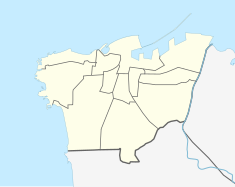Grand Serail
| The Grand Serail | |
|---|---|
| Native name السراي الكبير | |

The Serail Hill overlooking the Beirut central district
|
|
| Location | Beirut, Lebanon |
| Coordinates | 33°53′45″N 35°30′03″E / 33.895926°N 35.500934°ECoordinates: 33°53′45″N 35°30′03″E / 33.895926°N 35.500934°E |
| Area | 39,700 m2 (427,000 sq ft) |
| Built | 1853 |
| Built for | Ottoman army |
| Architectural style(s) | Ottoman new order |
| Governing body | Directorate General of Antiquities |
| Type | Cultural |
The Grand Serail (Arabic: السراي الكبير (Al-Sarāy al-Kabir)(French: Le Grand Serail); also known as the Government Palace) is the headquarters of the Prime Minister of Lebanon. It is situated atop a hill in downtown Beirut a few blocks away from the Lebanese Parliament. The Grand Serail is a historic building, the most important of three Ottoman monuments on the Serail hill. The other two are the Council for Development and Reconstruction and the Hamidiyyeh clock tower. This historic building has earned its importance through successive roles which it held since 1832
After its short-lived victory over the Ottomans in 1831, an Egyptian military contingent took position and set up its barracks on the western side of a hill overlooking Beirut and outside its walls.Ibrahim Pasha selected this hill for military reasons. It was a high hill overlooking Suq-al Munajjidin (the weavers' bazaar), this Suq, known today as the banks street (shari' al Massarif), was located on a strategic area within downtown Beirut, and close to Tal'at al American (American Hill), near Bab Yaacub (Jacob's Gate). In his book "Taqwim al Ikbal" Sheik Abdel Basit al Unsi describes that hill as being well situated, west of the city, away from the population and overseeing the sea and Beirut. Thus because of its situation, it allows the contingent to control the city and its suburbs. While the Egyptians were on that hill, the people customarily referred to it as the "Al Thakanat" (the barracks) because it was the lodging place that was selected by Ibrahim Pasha for his troops.
In 1840, the Ottoman Empire with the support of the Prussian, Russian, and English navies, recaptured authority over Syria. The Ottoman military authority took interest in the hill overlooking Beirut and set up a military base there. The building was first used as the headquarters of military and civilian departments and then, after its expansion, it turned into the headquarters of Ottoman governors. Beirutis referred to it then as al Quishleh (modern Turkish: Kışla), a Turkish word for "Garrison" or "soldiers quarter". Construction and fortification of the barracks was started in 1853 and was further expanded during the Crimean war. Until 1856 the Grand Serail only consisted of a single floor, another floor was added and the ground floor then served as the cavalry stables. Between 1877 and 1894 major structural modifications were made which gave the Serail its final form.
...
Wikipedia

